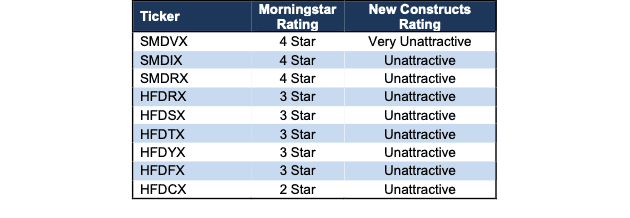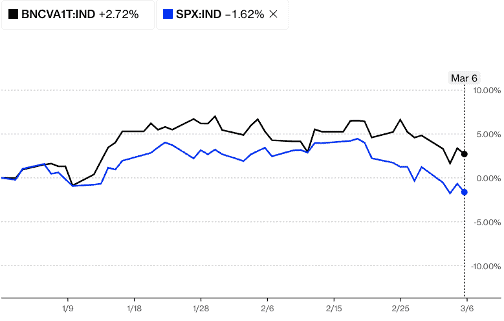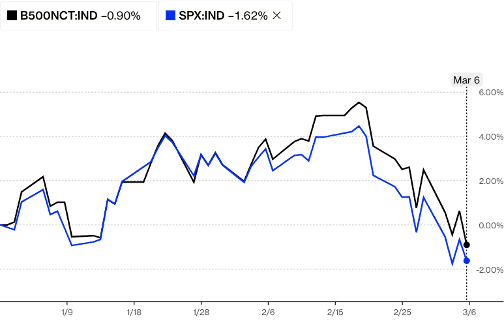Picking good stocks is hard, which is why many investors are drawn to ETFs and mutual funds.
The problem with that strategy is that it assumes fund managers pick good stocks when, for decades, we’ve known that 75%+ funds underperform their benchmarks every year. Every year!!
So, how can you gain some insight into whether or not a fund will outperform? Look at past price performance? No. How about analyzing each of the holdings of a fund? Yes!
That’s exactly what we do for our forward-looking Fund Ratings for 7,600+ ETFs and mutual funds. After scouring our coverage universe, we found a mid-cap mutual fund that allocates too much capital to bad stocks. To make matters worse, it charges well above-average fees for its below average (compared to the benchmark and overall market) portfolio. Hartford Schroders U.S. Mid Cap Opportunities Fund (SMDVX) is this week’s Danger Zone pick.
Forward-Looking Research Protects Investors
Most legacy fund research is backward-looking. It is based on past price performance. Our fund research is forward-looking and based on proven-superior fundamental analysis and ratings on each individual holding.
SMDVX earns our Very Unattractive (equivalent to Morningstar’s 1 Star) rating while Morningstar gives SMDVX a 4 Star rating. Figure 1 shows how our forward-looking Fund Ratings compare to Morningstar’s (MORN) ratings.
SMDIX and SMDRX, two other share classes of the mutual fund, also earn a 4 Star rating while we rate them Unattractive. HFDRX, HFDSX, HFDTX, HFDYX, HFDFX earn a 3 Star rating, and we rate all of them Unattractive. HFDCX, which we rate Unattractive, is the only share class that earns a 2 Star rating.
Figure 1: Hartford Schroders U.S. Mid Cap Opportunities Fund Ratings
Sources: New Constructs, LLC, company filings, mutual fund filings, and Morningstar
Hard to Trust a Methodology that Lacks Transparency
Hartford Schroders U.S. Mid Cap Opportunities Fund looks for three types of companies with distinct objectives: capital growth, lower downside volatility, and idiosyncratic growth.
The fund’s prospectus goes on to note the fund’s sub-adviser uses “bottom-up fundamental analysis to select securities.” More specifically, the fund’s sub-advisor seeks to identify securities that offer the potential upside based on:
- novel, superior, or niche products or services,
- sound operating characteristics,
- quality of management
- an entrepreneurial management team,
- opportunities provided by mergers, divestitures, or new management,
- or other factors.
However, details on how the sub-adviser calculates or quantifies any of the items above is absent. Without such information, we can only judge SMDVX’s managers based on what we can measure: the quality of the stocks they hold in their fund.
Our analysis reveals SMDVX’s investment process leads to holdings with lower returns on invested capital (ROIC), lower cash flows, and more expensive valuations than its benchmark and the S&P 500. See below.
Holdings Research Reveals a Low-Quality Mid Cap Portfolio
Our holdings analysis, which leverages our Robo-Analyst technology[1], reveals that SMDVX holds lower-quality stocks than its benchmark iShares Russell Mid Cap ETF (IWR). For reference, IWR earns a Neutral rating.
Per Figure 2, SMDVX allocates 57% of its portfolio to Unattractive-or-worse rated stocks compared to 45% for IWR. On the flip side, SMDVX allocates only 9% of its assets to Attractive-or-better rated stocks compared to 14% for IWR.
Figure 2: Hartford Schroders U.S. Mid Cap Opportunities Fund Allocates to Far Worse Stocks than IWR
Sources: New Constructs, LLC, company, ETF, and mutual fund filings
Per Figure 3, our holdings analysis also reveals SMDVX’s portfolio is lower quality than the S&P 500, as represented by State Street SPDR S&P 500 ETF (SPY), which earns an Attractive rating.
At just 33% of its portfolio, SPY allocates less to Unattractive-or-worse rated stocks compared to SMDVX.
Figure 3: Hartford Schroders U.S. Mid Cap Opportunities Fund Allocates to Worse Stocks than SPY
Sources: New Constructs, LLC, company, ETF, and mutual fund filings
Given SMDVX allocates just 9% of assets to Attractive-or-better rated stocks, it appears poorly positioned to generate the outperformance required to justify higher active management fees.
Expensive Stocks Drive Very Unattractive Risk/Reward Rating
Figure 4 shows our detailed rating for SMDVX, which includes each of the criteria we use to rate all ETFs and mutual funds under coverage. These criteria are the same for our Stock Rating Methodology, as the performance of a mutual fund equals the performance of its holdings minus fees. Figure 4 also compares SMDVX’s rating with those of IWR and SPY.
Figure 4: Hartford Schroders U.S. Mid Cap Opportunities Fund Rating Details
Sources: New Constructs, LLC, company, ETF, and mutual fund filings
As Figure 4 shows, SMDVX is inferior to IWR in four of the five criteria that make up our Portfolio Management rating. Specifically:
- SMDVX’s ROIC is 10%, which is lower than IWR’s (13%) and SPY’s (33%) ROIC.
- SMDVX’s 2-yr average free cash flow (FCF) yield of 1% is lower than IWR’s and SPY’s at 2%.
- The price-to-economic book value (PEBV) ratio for SMDVX is 5.9, which is greater than the 3.9 for IWR and 3.8 for SPY.
- Our discounted cash flow (DCF) analysis reveals an average market-implied growth appreciation period (GAP) of 72 years for SMDVX’s holdings compared to 59 years for IWR’s and 72 years for SPY’s holdings.
Market expectations for stocks held by SMDVX imply profits will grow substantially more than the stock’s held by IWR and SPY (measured by PEBV ratio), despite IWR’s and SPY’s holdings being much more profitable (as measured by ROIC).
This rigorous holdings analysis reveals that SMDVX provides exposure to less profitable mid cap companies, while taking much more valuation risk than the benchmark and S&P 500.
High Fees Make Owning SMDVX Worse
At 3.54%, SMDVX’s total annual costs (TAC) are higher than 95% of Mid Cap Blend mutual funds under coverage. For comparison, the simple average TAC of all the Mid Cap Blend mutual funds under coverage is 1.56% and the asset-weighted average is 1.11%. IWR charges just 0.21% and SPY has total annual costs of just 0.10%. Why pay higher fees for inferior stock selection?
Our TAC metric accounts for more than just the expense ratio. We consider the impact of front-end loads, back-end loads, redemption fees, and transaction costs – the latter of which adds 0.10% to SMDVX’s TAC.
Figure 5 shows our breakdown of SMDVX’s total annual costs, which we provide for all ~6,300+ mutual funds and ~1,300+ ETFs under coverage.
Figure 5: Hartford Schroders U.S. Mid Cap Opportunities Fund’s Total Annual Costs Breakdown
Sources: New Constructs, LLC, company, ETF, and mutual fund filings
To justify charging higher fees, SMDVX must outperform its benchmark by 332 basis points annually over three years.
However, SMDVX’s load-adjusted 3-year quarter-end average annual total return has underperformed IWR by 590 basis points and SPY by 1,553 basis points. SMDVX has also underperformed over the 1-year, 5-year, and 10-year periods.
Given that 57% of assets are allocated to stocks with Unattractive-or-worse ratings, and 87% are allocated to stocks with Neutral-or-worse ratings, SMDVX is likely to continue underperforming.
Get an Edge from Holdings-Based Fund Analysis Based on Superior Stock Research
We offer clients in-depth reports for all ~7,600+ ETFs and mutual funds under coverage. Click below for a free copy of our SMDVX standard mutual fund report.
Smart fund (or ETF) investing means analyzing each of the holdings of a fund. Failure to do so is a failure to perform proper due diligence. Simply buying an ETF or mutual fund based on past performance does not necessarily lead to outperformance. Only thorough holdings-based research can help determine if a fund’s methodology leads managers to pick high-quality or low-quality stocks.
Our Robo-Analyst technology analyzes the holdings of all 349 ETFs and mutual funds in the Mid Cap Blend style and 7,600+ ETFs and mutual funds under coverage to avoid “the danger within”.
Easily Make Any Fund, Even SMDVX, Better
As we show in The Paradigm Shift to DIY ETFs, new technologies enable investors to create their own fund without any fees while also enabling better, more sophisticated weighting methodologies. For example, if we reallocate the fund’s capital to the companies with the best Core Earnings, our customized fund allocates:
- 17% of assets to Attractive-or-better rated stocks (compared to 9% for SMDVX)
- 37% of assets to Unattractive-or-worse rated stocks (compared to 57% for SMDVX)
Compare the quality of stock allocation in as-is SMDVX vs. our customed version of SMDVX in Figure 6.
Figure 6: Hartford Schroders U.S. Mid Cap Opportunities Fund Allocation Could Be Improved
Sources: New Constructs, LLC, company, and mutual fund filings
Note that our DIY ETF tool allows clients to pick and weight portfolio holdings based on multiple proprietary metrics, such as Core Earnings, Economic Earnings, Free Cash Flow, Net Operating Profit After Tax and more.
Check Out Indices Based on New Constructs Research
While we’re talking about creating your own fund, we should highlight the indices we’ve developed with Bloomberg’s Index Licensing Group. Both are outperforming the S&P 500 this year. See Figures 7 and 8.
We have multiple indices in production now. You can get more details on them here.
- Bloomberg New Constructs 500 Index (ticker: B500NCT:IND)
- Bloomberg New Constructs Ratings VA-1 Index (ticker: BNCVA1T:IND).
Figure 7 compares the performance of the Very Attractive Stocks Index, managed by Bloomberg, to the S&P 500. Since January 1, 2025, the Bloomberg New Constructs Ratings VA-1Index (ticker: BNCVAT1T:IND) is up 2.7% while the S&P 500 is down 1.6%.
Figure 7: Very Attractive-Rated Stocks Strongly Outperform the S&P 500 Year to Date
Sources: Bloomberg
Note: Past performance is no guarantee of future results.
Figure 8 compares the performance of the Bloomberg New Constructs 500 Total Return Index, managed by Bloomberg, to the S&P 500. Since January 1, 2025, the Bloomberg New Constructs 500 Total Return Index (ticker: BNCVAT1T:IND) is down 0.9% while the S&P 500 is down 1.6%.
Figure 8: Bloomberg New Constructs 500 Index Strongly Outperforms the S&P 500 Year to Date
Sources: Bloomberg
Note: Past performance is no guarantee of future results.
Better Options for Mid Cap Blend Funds
Below we present Mid Cap Blend ETFs or mutual funds that feature an Attractive rating, >$100 million in assets under management, and below average TAC:
- Alpha Architect U.S. Quantitative Value ETF (QVAL) – 0.32% TAC and Very Attractive rating
- State Street SPDR Russell 1000 Volatility Focus ETF (ONEV) – 0.22% TAC and Very Attractive rating
- Invesco Bloomberg Analyst Rating Improvers ETF (UPGD) – 0.44 TAC and Very Attractive rating
- Gotham 1000 Value ETF (GVLU) – 0.55% TAC and Very Attractive rating
- Jensen Quality Mid Cap Fund (JNVSX) – 0.96% TAC and Very Attractive rating
This article was originally published on March 10, 2025.
Disclosure: David Trainer, Kyle Guske II, and Hakan Salt receive no compensation to write about any specific stock, sector, style, or theme.
Questions on this report or others? Join our online community and connect with us directly.
[1] See Harvard Business School case study: New Constructs: Disrupting Fundamental Analysis with Robo-Analysts.








